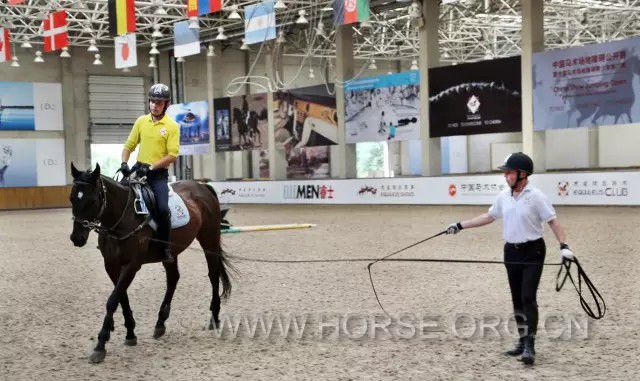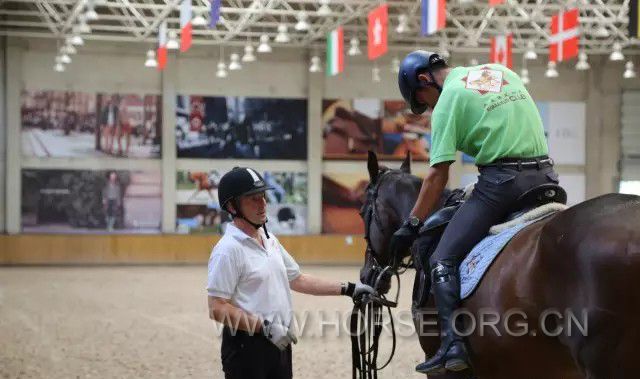马上注册,结交更多马友,享用更多功能
您需要 登录 才可以下载或查看,没有账号?立即注册
x
在骑乘课上,我们经常会听到教练询问诸如“你感觉到了吗?”或“那个转换感觉像什么”之类的问题,也会听到教练告诉学员“这种练习有助于提升你的马感”。那么,“感觉”到底是什么呢?

杰瑞米•麦克尔斯(Jeremy Michaels)
Jeremy长期担任英国马会BHS训练和马术学科总监以及教育总监一职,现任英国马会BHS考试总考官和西英格兰大学哈特伯瑞学院马术学科讲师 。
自2002年起,Jeremy协助中国马术协会及天星调良国际马术俱乐部完成俱乐部星级认证及教练员资格认证,并协助天星调良国际马术俱乐部完成了国际马术培训及考试中心认证、国际马术骑乘中心和马主马房管理中心的认证。

那些少数的奥运骑手似乎是为马而生,难道“马感”仅仅是专属于像他们这样的马术精英吗?我们这些平常人难道就不能拥有吗?还是说我们只是在浪费时间,这感觉永远是可望而不可及的?
为什么当学员模仿着教练上马,它接下来一系列动作就像长颈鹿那样笨拙?它抬头,张嘴磨牙,背部凹陷,后肢向外甩;但教练如何轻而易举,调教仅仅2分钟,就让相同的马匹变得如此优雅,似乎立即就可以参加一个高级别的舞步比赛?

对学员来说,这可以是一件非常令人沮丧和懊恼的事情,但同时也是如此神奇,值得我们花时间去思考、去琢磨这种变化如何发生。这两种情况我都有切身体会。一种是当我培训教练时,我可以看到他们是如何将一匹抗拒、身体僵硬如木板的马匹变得柔软、灵活并高度配合骑手。另一种情况则是我本人作为一名教练需要将这些僵硬的“问题”马变成温和、服从的好伙伴。

在教学和训练马匹这两方面上,经验让我非常理解这种困难与沮丧。我的客人所拥有的马匹或多或少都存在着这样那样的问题,并且需要更多地放松并附有灵活性地练习来鼓励马匹向前运动。所以有时我会去骑这样的问题马,并向马主解释并说明我在做什么,为什么这样做。这样不论是马主本身还是他的骑手都会明白要怎么才能做到将马匹骑“软”。教练上马,自己安静地骑20分钟后,下马,再让骑手回到马背上,并且告诉他“这马现在好多了”,没有比这更让骑手沮丧的了。“是的,这匹马现在好多了。”但是你是怎么做到的?
作为客人和学生,他们最想知道教练是如何调教马匹的。难道是有什么魔术吗?或是教练趁别人不注意的时候给马喂了什么药吗?还是说教练会说“马语”,他告诉马匹自己在的时候要好好表现,而骑手或是马主一旦上马,就恢复长颈鹿一般的状态?

我相信每个人都有感觉,只是感觉程度不同。任何人都能察觉到慢步、快步和跑步之间的区别。这也许是人总体的感觉,但至少他们能感受到某些东西。即使并非所有骑手都能感觉到马要何时跳过障碍,但大多数是可以的,至少马匹跳障碍他们是能感觉到的。

从我个人经验来讲,我渴望学习,越多越好,越快越好,并在这个过程当中去提升我的“感觉”,尽我所能地将马骑好。我并非出生于马术世家(母亲也仅是常常娱乐性的骑马,我们没有自己的马匹,当然也没有马在我家四处嬉戏。)因此,我没有所谓的与生俱来的感觉。我不得不更加努力地骑马,来达到我现有的水平。在我学习和教学生涯中,我观察了上百个优秀的障碍骑手和普通教练是如何骑乘和比赛;自己也骑过百余匹马,不得不说当中的大部分并不是天赋异禀;我同样教过上百名年龄不同、能力相异的骑手,参加过上百个舞步比赛,障碍比赛和三项赛;我阅读过上百本关于骑术的书籍,看过诸多DVD和视频资料。然而对我帮助最大的却是观察上百位教练是怎样做的,以及听他们说为什么要那样做。我提出过上百个疑问来探寻为什么、是什么、在哪里、什么时候、是谁等等。勤学好问是成功最重要的因素!
未完待续
What's Feeling?(1)
In lessons, one often hears the coach asking questions such as, ‘Did you feel that?’ or ‘What did that transition feel like?’ or ‘This exercise will really help your feel’. So, what exactly is‘feel’?
Is it one of those aspects of riding that is reserved solely for the elite few who are Olympic riders or top trainers who look as if they were born on a horse? Can we mere mortals ever aspire to have the same amount of feel for a horse as one of our equestrian heroes? Or, are we wasting our time chasing the Holy Grail of equestrianism ?
How does our coach get on the horse that we made look like a giraffe (head up, hind legs positioned way out behind, hollow in the back, mouth open, teeth grinding) and after two minutes of seemingly doing very little, have the animal looking as if it could grace a high level dressage competition?
This can be frustrating and annoying but at the same time miraculous and well worth watching to see the incredible transformation. I have been in both situations—when training my coach could get on my resistant, argumentative,stiff plank of wood and with comparative ease, turn it into a soft, willing,flexible and supple horse. I too am now the coach who gets on the stiff, difficult horses and turns them into soft, submissive animals.
I believe I am a much more empathetic coach and rider because I have seen and experienced both sides of the training issue. The majority of my customers own horses that have problems; they are backward thinking (behind the leg) and require loosening and suppling work to encourage them to move forward on the bit. If my customer is struggling with their horse I do sometimes ride him and explain exactly what I am doing while I am doing it—this enables the rider to understand what is required and how to acquire it. There is nothing more disconcerting to acustomer for the coach to ride their horse and be stood in the middle of the arena while the coach silently rides the horse for 20 minutes, returns,dismounts and tells the rider to get back on and work the horse as he is ‘going much better now’! YES HE IS BUT HOW DID YOU DO THAT???
As the customer and pupil I would like to know how the coach manages to improve the horse—what magic does he use? Does he feed the horse a special potion while we are not looking? Does he speak ‘horse’ and whispers in his ears asking him to go well for a few minutes before reverting to that giraffe-like posture as soon as the owner or customer gets back on?
I sincerely believe that EVERYONE has feel. There are degrees of feel though. Everyone can feel the difference between the walk, trot and canter. This might be the sum total of a person’s feel but at least they can feel something! Most, if not all riders can feel when a horse jumps over a fence; again, this might be the most the rider can feel but at least they can feel it!
Talking from my personal experiences, I was hungry to learn as much as I could as quickly as I could with regard to developing feel and being able to improve and work horses to the best of my ability. I came from a non-horsey family (my mother used toride recreationally but we did not own horses and they certainly did not run inthe family) so there was no natural, inbred, innate ability which gave me‘natural’ feel. I have had to work hard to get where I am. During my learning and training years I watched hundreds of good (and not so good) riders both competing and training; I rode hundreds of horses—the vast majority not sotalented; I taught hundreds of riders of all ages and ability; I competed hundreds of horses in dressage, show jumping and eventing; I read hundreds of books and journals on riding plus, I watched DVD’s and videos. My greatest help though, was watching and listening to hundreds of coaches and trainers to tryand understand what and why they were doing. I asked hundreds of questions to explore why, what, where, when, who, which, etc. An inquisitive mind isessential to success.
(To Be Continued)
来源:天星调良马术
|
|